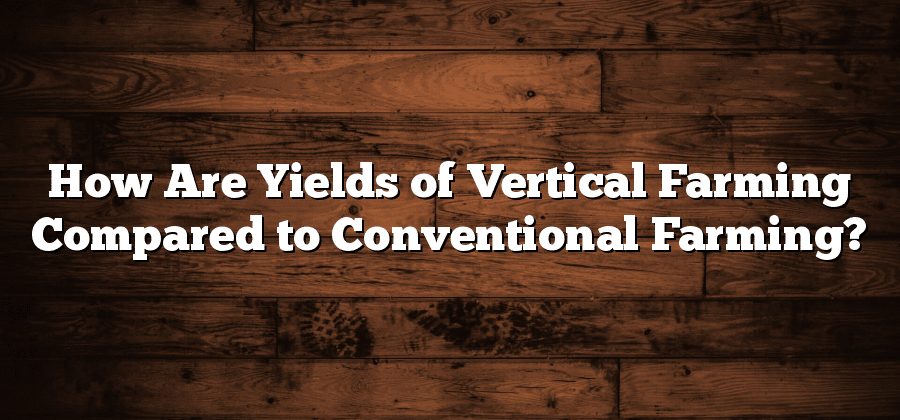Definition of Vertical Farming and Conventional Farming
Vertical farming is a modern agricultural technique that involves growing crops in vertically stacked layers, such as in a skyscraper or a controlled environment facility. This method aims to maximize the use of limited space and resources, making it suitable for urban areas where conventional farming may be challenging. By utilizing advanced technologies such as artificial lighting, hydroponics, and aeroponics, vertical farming provides an efficient and sustainable alternative to traditional farming methods.
Conventional farming, on the other hand, refers to the traditional agricultural practices that have been in place for many centuries. It involves growing crops on open fields, relying on natural sunlight and soil for plant growth. Conventional farming methods often incorporate the use of chemical fertilizers, pesticides, and herbicides to enhance crop productivity and protect against pests and diseases. While conventional farming has been the predominant method for food production, it comes with challenges such as dependence on seasonality, vulnerability to adverse weather conditions, and the need for large land areas.
Key Factors Affecting Yields in Vertical Farming
Vertical farming is an innovative approach to agriculture that involves growing crops in vertically stacked layers or structures. This method offers several advantages, such as year-round production, reduced land use, and minimal pesticide use. However, there are certain key factors that can significantly affect the yields in vertical farming.
One important factor is the quality and intensity of light. Since plants in vertical farms are grown in a controlled environment, artificial lighting plays a crucial role in stimulating photosynthesis and promoting plant growth. The type of light source, its intensity, and the duration of exposure all influence crop yields. Additionally, optimizing the light spectrum to match the specific needs of different crops can further enhance productivity. Efficient deployment of lighting technologies and constant monitoring of light levels are imperative for maximizing yields in vertical farming.
Key Factors Affecting Yields in Conventional Farming
There are several key factors that can greatly affect yields in conventional farming practices. One crucial factor is the availability and quality of water. Adequate irrigation is essential for the healthy growth of crops, and insufficient water supply can lead to stunted growth and reduced yields. In addition, the quality of the water used for irrigation can also impact crop productivity. If the water contains high levels of salts or other contaminants, it can negatively affect plant health and ultimately lead to lower yields.
Another critical factor that affects yields in conventional farming is the quality and nutrient content of the soil. Soil fertility plays a vital role in supporting plant growth and development. Poor soil quality, characterized by low organic matter content or imbalanced nutrient levels, can limit the plants’ ability to absorb essential nutrients. As a result, this can lead to nutrient deficiencies, stunted growth, and reduced yields. It is crucial for conventional farmers to regularly monitor and maintain soil fertility through practices such as crop rotation, nutrient management, and soil testing to optimize yields.
Comparison of Crop Yields in Vertical Farming
Vertical farming has gained considerable attention in recent years due to its potential to maximize crop yields in limited spaces. By utilizing vertical stacking and hydroponic systems, vertical farms are able to grow crops year-round, regardless of seasonal conditions. This not only eliminates the need for traditional agricultural practices such as crop rotation, but also allows for multiple layers of cultivation, significantly increasing the amount of crops that can be grown in a single area. Moreover, vertical farming incorporates advanced technology such as LED lighting and climate control systems, providing optimal growing conditions for plants, which further enhances the potential for higher crop yields.
Conventional farming, on the other hand, relies on traditional methods of growing crops in open fields. While it has been the primary method of agricultural production for centuries, conventional farming faces limitations in terms of land availability and environmental factors. The yield of conventional farming is largely dependent on variables such as weather patterns, soil quality, and exposure to pests and diseases. These factors can significantly impact crop growth and negatively affect overall yields. Furthermore, conventional farming typically requires larger land areas for cultivation, limiting the potential amount of crops that can be grown compared to vertical farming.
Comparison of Crop Yields in Conventional Farming
Conventional farming, also known as traditional or outdoor farming, has been practiced for centuries and remains the dominant method of crop production worldwide. In this system, crops are grown in open fields, relying heavily on natural sunlight, rainwater, and soil fertility. Factors such as weather conditions, pests, diseases, and limited land availability can greatly impact the yields in conventional farming.
One of the key factors affecting crop yields in conventional farming is the unpredictable nature of weather patterns. Extreme temperatures, droughts, floods, and storms can all lead to significant crop losses. Additionally, pests and diseases, such as insects, fungi, and viruses, pose constant threats to the health and productivity of crops. Farmers often resort to chemical pesticides and fungicides to combat these issues, which can further impact crop yields and have long-term environmental repercussions.
Despite these challenges, conventional farming has managed to achieve significant crop yields over the years. Advances in technology, such as improved irrigation systems and crop varieties, along with the use of fertilizers and pesticides, have played a crucial role in maximizing yields. However, it is important to note that the reliance on external inputs and the potential environmental impact are major concerns associated with conventional farming.






